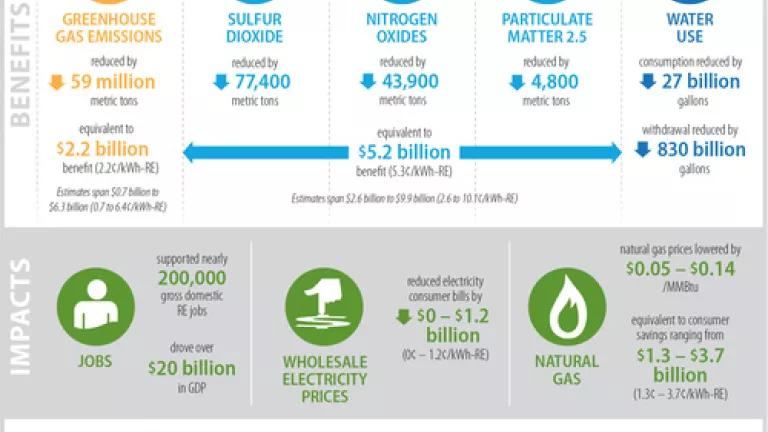
Across the country, 29 states and the District of Columbia have renewable energy standards that ensure utilities get a certain percentage of their electricity from clean sources like wind and solar power. In fact, 2015 saw some impressive expansions of those so-called Renewable Portfolio Standards: California and New York each committed to get 50 percent of their electricity from renewable sources by 2030, and Hawaii now promises a full 100 percent by 2045.
State renewable energy standards save lives, cut carbon pollution, create jobs, and save consumers billions on energy. Really, what's not to like? (Graphic: National Renewable Energy Laboratory)
In states like Michigan, North Carolina and Ohio, though, RPSs are under attack. Opponents, often well-funded by oil billionaires Charles and David Koch, portray these standards as wallet busters and job killers, usually in that order. New research out yesterday, however, finds just the opposite. Building on previous National Renewable Energy Laboratory research that found RPS compliance increased the average cost of electricity by less than 2 percent--that is, compliance raised the cost of a kilowatt hour of electricity from 10 cents up to 10.2--yesterday's NREL analysis finds a host of benefits that aren't normally factored into the retail cost of electricity but make the case for RPSs and renewable energy in general even stronger.
Here are the highlights:
State RPSs cut electric and natural gas costs for consumers--Pollution-free wind and solar power is increasingly cost-competitive. As a result, Americans saved as much as $1.2 billion on their electric bills, from new, RPS-compliant wind and solar farms that came online in 2013. That's not chump change. In fact, it's about 1.2 cents a kilowatt hour. Add to that the significant cost savings on natural gas that results from reduced demand in fossil-fuel-fired power plants. The total there: between $1.3 and $3.7 billion in additional savings for residential, business and industrial customers. Not too tough on the wallet at all.
State RPSs create jobs--NREL estimates that state RPSs--responsible for about 58 percent of all renewable energy in the US--created 200,000 jobs in 2013. Those jobs were good-paying jobs, too, with full-time employment averaging $60,000 annually.
State RPSs save lives, prevent illnesses--Nationwide, state RPSs staved off between 320 and 1,100 premature deaths in 2013, by preventing dangerous power-plant pollutants from fouling our air. All told, RPSs prevented 77,4000 metric tons of sulfur dioxide, 43,900 metric tons of nitrogen oxides, and 4,800 metric tons of fine particulate matter. (These pollutants are linked to asthma and other respiratory problems, heart disease and cancers, among other illnesses.) Those numbers don't even count reductions in mercury, which would bring the lifesaving/illness prevention totals even higher.
RPSs didn't just save lives, by the way. They also improved our well-being in 2013, preventing between 160-290 emergency room visits, 195-310 hospital admissions, 40-560 non-fatal heart attacks, and 38,000-64,000 lost days of work and school.
State RPSs save water, especially in drought-plagued states--In these dry days, RPSs are saving significant amounts of water, because conventional and nuclear power plants both consume and withdraw water from our rivers and lakes. Wind and solar power, by contrast, require virtually none of the stuff. As a result, in 2013, new, RPS-compliant renewable energy prevented a walloping 27 billion gallons of water consumption and prevented withdrawals, which bring much ecosystem damage, of a mind-blowing 830 billion gallons. "The largest withdrawal and consumption reductions were in California and Texas, respectively," the NREL authors write, "demonstrating the important benefits" of RPSs in some of the country's most drought-prone states.
State RPSs reduce greenhouse gas emissions--Wind and solar power brought online by state RPSs in 2013 kept 59 million metric tons of carbon pollution out of our significantly overloaded atmosphere--the equivalent of more than 15 coal-fired power plants.
As yesterday's NREL report shows, state RPSs bring benefits worth billions of dollars to residents of states lucky enough to have them. And while RPS opponents can and do opine about the many supposed downsides of state renewable energy standards, yesterday's report shows, the facts just aren't on their side.

